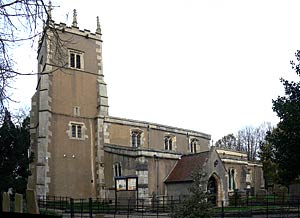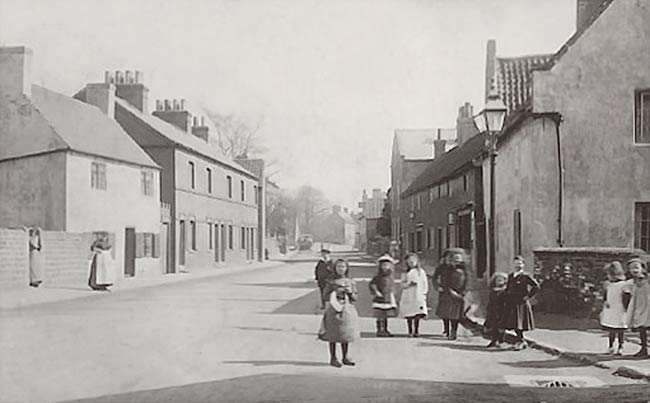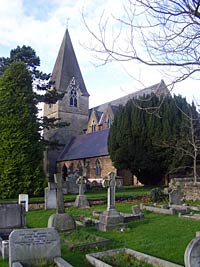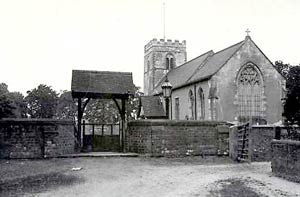< Previous | Contents | Next >

Farndon church in 2009.
© Copyright Alan Murray-Rust and licensed for reuse under this Creative Commons Licence
FARNDON. It lies between the old Fosse Way and an elbow of the Trent where the ferry crosses to Rolleston. In the middle of the village, at the end of a quaint avenue of lopped limes by high ivied walls, is the church, with fragments perhaps from Saxon days.
The tower is mainly 14th century, with later windows. A beautiful 13th century arcade with pillars of grouped shafts divides the nave from the south aisle. The other arcade and its aisle have been rebuilt, but it is in the north wall that we find the oldest work, in crude herringbone masonry, seen outside, and a simple round-headed doorway. They are part of the first church on this site and are early Norman or Saxon. There is a broken stone coffin in the church.
The clerestory and a few windows are 14th century. The font is as old, but its richly pinnacled cover, like the oak screen, is modern. The simple oak roof of the nave has richly moulded 17th century beams, and the chancel has its old piscina.
Exploring a Continent

Main Street, Farnsfield, c.1905.
FARNSFIELD. This fine red patch in a green countryside gave Australia a famous explorer and has traces of ancient camps round about.
One of the camps was where Combs Farm is perched on a hill, and is reached by a winding lane. Looking out on climbing woods carpeted with bluebells, it was one of two promontory fortresses in the county, used by the Romans but of earlier origin. On the other side of the village is Camp Hill, an ancient earthwork near the finely wooded Hexgrave Park where a bridle road winds through beautiful avenues of limes.

Farnsfield church in 2009.
© Copyright steven ruffles and licensed for reuse under this Creative Commons Licence
Attractive outside with red stone walls, gabled clerestory windows, and a spire, the church stands near the small three-cornered green in a churchyard with an ancient stone pillar and a slender peace memorial cross. The lower part of the tower comes from about 1400, and is all that is left of the original structure, the rest being rebuilt last century. A curious feature of the tower is that its north wall, with an outside buttress, is enclosed inside the new building. The font is the only old relic.
Here was born Augustus Charles Gregory, and here he spent his early days before going out to Australia with his father. A brave explorer and scientist, his long life of public service was a great asset to the new land. His father was head of an old Notts family, Lieutenant Gregory, who, wounded in Egypt, received in compensation a grant of land on the Swan River in Western Australia, sailed with Augustus and two other sons, and settled down to colonise in 1829, Augustus then ten years old. Their education completed, the three brothers entered the survey department, and from that time forth their names occupied a foremost place on the roll of men who, little by little, penetrated and revealed the mysteries, wonders, and grim terrors of the island continent. Augustus was the leading spirit; by instinct and training he seemed predestined for his formidable task.
His active work embraced twenty years of skilled and daring effort, and in that time he penetrated east, west, north, south. His first journey, beginning at Bolgart Spring, gave him his first shock, for his progress to the east was soon barred by an immense salt lake. North-west, however, they made the first discovery on the continent of rich seams of coal. In 47 days Gregory covered 1000 miles. More fruitful still was his expedition to explore the Gascoyne River. It was in 1848, when thrones were toppling in Europe, that Gregory saw what seemed a Promised Land inviting all who would to settle, the Murchison and Champion Bay areas with all their prospect of pastoral wealth. His fame had by this time reached home, and the Royal Geographical Society sent him forth in 1855 to explore the interior. Five thousand miles of territory were added to the map by this work, which brought its leader the founder's medal of the society.
This was Gregory's last addition to our knowledge of the unknown wastes, but he did valuable work as surveyor-general for Australia, as geological surveyor, as member of the legislature, as a protector of the aborigines, and as unwearying promoter of the scientific advancement of his adopted country. He died in 1905.
Martin Frobisher's Manor
FINNINGLEY. Three open greens adorn its winding ways, one shaded by a great oak, one where we turn by the school to find the church, and the biggest with its lofty elm in the middle of the village. Cottages, farms, and smithy are gathered about this spacious green, with a duck pond close by, and on one side the manor farm in company with four grand elms; it comes from a rebuilding of the old manor house half a century ago.
The manor was Swayne's before the Conquest, and its most famous owner since was Martin Frobisher, the intrepid seaman of Elizabethan days. It was held by his family till the end of the 17th century, when Cornelius Vermuyden, the great Dutch engineer, acquired land here in connection with the attempt then being made to drain the fenland east of the village.
Nottinghamshire's most northerly village, Finningley is part of a curiously projecting bit of the county which makes a right angle between Yorkshire and Lincolnshire. To reach it from the south we come through some miles of Yorkshire, and its station and one of its inns are actually over the border. The inn is called the Horse and Stag, and its metal sign, showing a horse holding down a stag with its foot, illustrates a story in the parish register of a horse coming to its master's aid when he was attacked by a stag in 1707.
Before the little school and its schoolhouse were built the school was in the churchyard, which served as a playground. We may be sure John Bigland would know the old school, for he was master here some years. He wrote a host of educational books, and is remembered as one of our forerunners, for he wrote a fine survey of Yorkshire in a wonderful series of books known as the Beauties of England a century and more ago.

Finningley church, c.1910.
Now all is peace in the churchyard, at the end of a little road overhung by the fine trees in the rectory garden. It is a fitting setting for the ancient church, which is of much more interest than its modest appearance suggests. Except for the embattled parapet, the Normans built the low tower with two tiny splayed windows in its west wall, belfry windows with central shafts, and a fine archway to the nave.
They built the beautiful doorway letting us in, with simple mouldings and capitals with worn carving. The plain font and some masonry in the south wall are also of their day.
The porch with a stone roof was made new last century, and has a timbered and gabled front. Built into its walls are four coffin stones and fragments of others engraved with crosses, one with a pair of shears by the stem.
The nave arcade comes from about 1280, as does the fine arch on clustered pillars opening to the 14th century chancel, which has three sedilia and a piscina with two drains. The only coloured glass fills the east window with realistic scenes of the battlefield, stark tree trunks and shattered buildings, and angels with trumpets above a figure of Our Lord whose hand is on the shoulder of a soldier. It is a tribute to those who served in the war, and to 22 who did not return. The oak pulpit was made in the year after Queen Elizabeth died, and from the close of that century comes a wooden memorial with a canopied frame.
Perhaps the chief charm of this bright place lies in the open timber roofs, with much fine decoration. Six kingposts in the nave have curved and carved braces, and on the tie-beams are medallions of flowers and floral bosses, one showing foliage coming from a quaint head. With the 17 floral bosses in the chancel is a crowned king with his sword and sceptre, and another has a bishop with staff and cross.
